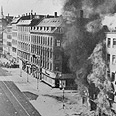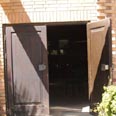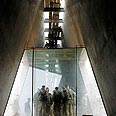Types of memorial sites range from small displays put together by survivors' relatives in remote places in the periphery, to large, well-known institutions such as Tel Aviv's Beth Hatefutsoth or Yad Vashem in Jerusalem, which have become world-renowned research and exhibition centers.

Beth Hatefutsoth (photo: Shaul Golan)
Size doesn't matter
Despite the lack of funds and resources, the museums that stand out most seem to be the smaller ones, with much heart and soul put into them, as they are designed by people wishing to commemorate loved ones from the neighborhood, old friends from town, synagogue or people with whom they shared the tragedies of the ghetto and concentration camps.Some of the museums focus on specific communities wiped out during the Holocaust, while others present a bigger picture by displaying art from the ghettos. Some museums stress perpetuating the memory of the resistance and courage, and others stress the historical aspect and link to Diaspora Jews.
Different sites have different displays to offer, and in smaller sites with budgeting problems, one may find mainly photographs and documents of those who perished. The larger museums however, have turned into international information and research centers, and interactive museums that provide their visitors with an emotional experience, either by cutting-edge equipment, or modern technology such as videos and computers. Either way, a visit to such a place would remain etched in ones memory.
Funding for these museums comes mainly from donations and symbolic entrance fees which partially help sustain the facilities. Many of the workers in these establishments work as volunteers, out of a feeling of a divine mission.
In part of the museums entrance is free, but joining a guided tour comes with a symbolic payment. The museums that do charge entrance fees, usually take between NIS 15 - NIS 40 (about $4 - $10) per visitor.
In any event, it is best to call and check what kinds of activities the site has to offer before arriving, especially around Holocaust Memorial Day.
Here is a list of national memorial sites:
Memorial Museum of the Hungarian Speaking Jewry, Safed
The museum was founded in 1986 and opened to the public in 1990 in Safed. The Museum is based on a non-profit Association with thirty founding members and has been operated from the start by two of its founders: Hava and Yosef Lustig.
The Museum depicts the magnificent past of the Jewish communities in Hungary, Transylvania, Slovakia, Carpathian-Russia, Bachka, Banat and Burgenland, and reflects their contribution to the Jewish history and world culture.
The museum presents thousands of books, documents, certificates, diaries and photographs of the Jewish communities that were murdered in the Holocaust.
Memorial Museum of the Hungarian Speaking Jewry
Kikar Haazmaut,
Safed, 13111, Israel
Tel/Fax: +972-4-6923880, +972-4-6925881
Opening hours: Sun-Fri: 9:00-13:00
Entrance fee required
The Yitzhak Katzenelson Holocaust Resistance Museum, Kibbutz Lohamey Hagetaot
The museum was founded in 1949 by a group of Holocaust survivors, members of Jewish ghetto resistance groups in Poland and former partisan units. The museum contains various different exhibitions on the resistance including maps of ghettos and concentration camps.
The museum is a great source for research and study on Holocaust and resistance topics. The museum also uses exhibitions, books, movies, lectures and seminars to illustrate the horrible fate the Jews suffered during the Holocaust.
Recently, a new feature has been added to the museum, an archive available to visitors that links the past and the present.
Kibbutz Lohamey Hagetaot
Tel: +972-4-9958080
Opening hours: Sun-Thu: 9:00-16:00, Fri: 9:00-13:00, Sat: 10:00-17:00
Entrance fee required
Illegal Immigrants Detention Camp, Atlit
The exposition depicts the camp which was built by Britons in 1938 for Jews coming illegally to Palestine. A tour of the camp authentically portrays the tragic stories of survivors who were forced to become immigrants and their fight for their human rights.
The museum has a computerized information center which allows visitors to identify their loved ones that lived through the Holocaust and made their way to the Land of Israel on ships.
Tel: +972-4-9841980
Opening hours: Sun-Thu: 9:00-17:00, Fri and holiday eves: 9:00-13:00
Entrance fee required

Illegal Immigrants Detention Camp, Atlit (photo: Elad Gershgorn)
Beit Theresienstadt at Kibbutz Givat Chaym Ichud
Beit Theresienstadt (or Beit Terezin) was erected in memory of the Jews of Ghetto Theresienstadt who perished during the Nazi persecution. The corner stone was laid in 1969 and the official opening was in 1975.
The museum displays the works of artists from the Terezin ghetto and uses computerized archives to provide detailed information on each and every Jewish prisoner that was held in the ghetto, and large collection of pictures of the prisoners' works.
Also available in the museum are original certificates, a collection of documentaries and survivors' verbal testimonies.
Tel: ++972-4-6369515
Opening hours: Sun-Thu: 9:00-13:00
Entrance fee required for groups. Individuals enter free of charge
Hana Senesh House, Sdot-Yam
Hana Senesh was a famous parachute jumper during World War II who parachuted into Yugoslavia during the war in order to help save the Jews of Hungary, who were about to be deported to the German death camp at Auschwitz.
Senesh was arrested at the Hungarian border, imprisoned and tortured, but refused to reveal details of her mission, and was eventually tried and executed by a firing squad. The exposition tells the visitors the story of her life.
Tel: ++972-4-6364367
Opening hours: Sun-Thu: 10:00-16:00
Entrance fee required
Massuah Museum, Kibbutz Tel Itzhak
The Museum comprises six permanent exhibitions that combine progressive educational approaches with state-of-the-art interactive technology.
Alongside historical facts about the Holocaust, the exhibitions offer different perspectives on what happened, thereby exposing visitors to questions and dilemmas from the Holocaust period that are relevant to their lives and identities today.
The exhibition spaces at the historical-educational museum also serve as study centers.
Kibbutz Tel Itzhak
Tel: ++972-9-8999563
Opening hours: Sun-Thu: 9:00-13:00
Entrance fee required for guided tours. Individuals enter free of charge

Poster at Massuah museum (photo: Yaffe Raziel)
Yad Vashem, Jerusalem
The Holocaust Martyrs' and Heroes' Remembrance Authority was established in 1953.
Since its inception, Yad Vashem has been entrusted with documenting the history of the Jewish people during the Holocaust period, preserving the memory and story of each of the six million victims, and imparting the legacy of the Holocaust for generations to come through its archives, library, school and museums.
Yad Vashem has many sections worth visiting, including The Hall of Names, The Hall of Remembrance and the Children's Memorial.
Yad Vashem Museum
Har Hzikaron, Jerusalem
Tel: ++972-2-6443400
Tel for group reservations: ++972-2-6443802
Opening hours: Sun-Wed: 9:00-17:00 Thu: 9:00-20:00 Fri and holiday eves: 9:00-14:00
Entrance is free of charge

Yad Vashem's Hall of Names (photo: Ardon Bar-Hama)
The Chamber of the Holocaust, Jerusalem
The museum was established in 1948 on Jerusalem's Mt. Zion. It contains hundreds of memorial plaques for the Jewish communities that were destroyed in the Holocaust, with different geographical areas separated by different rooms.
The site is affiliated with the Haredi community and therefore lacks any Zionist components. The Zionist movement and the State of Israel are not mentioned in any of the displays.
The Chamber of the Holocaust
Mt. Zion
Tel: ++972-2-67151105
Opening hours: Sun-Thu: 9:00-15:45, Fri: 8:00-13:00
Entrance fee required
The Nahum Goldmann Museum Of The Jewish Diaspora - Beth Hatefutsoth
The museum aims to convey the story of the Jewish people from the time of their expulsion from the Land of Israel 2,500 years ago to the present.
It relates the unique story of the continuity of the Jewish people through exhibition, education and cultural endeavors, providing multiple avenues of personal historical identification.
A new display opening at Beth Hatefutsoth this year is called, "Dreaming in English - Portraits from the Jewish Community in Melbourne, 1989-2006 / Photographs by Angela Lynkushka"
Beth Hatefutsoth,
The Nahum Goldmann Museumof the Jewish Diaspora
Tel Aviv University Campus
Klausner Street
Ramat Aviv, P.O.B. 39359
Tel Aviv 61392
Te/Fax: ++972-3-6408000/++972-3-6405727
Opening hours: Sun-Thu: 10:00-16:00, Wed: 10:00-18:00
Entrance fee required
Yad Mordechai Museum, Kibbutz Yad Mordechai
The museum was founded in 1965 in the memory of Mordechai Anielewicz, a Warsaw ghetto commander. The museum was built near the military cemetery and commemorates the two most significant events of the Jewish people in modern times: The Holocaust, and the foundation of the State of Israel.
The museum is dedicated to Europe's Jews from the period before the Holocaust up until immigration and settlement. Among other things, displays include information on European Jews' economic, cultural, artistic and educational history, Jews under Nazi occupation, the ghettos and the resistance.
The museum has a computerized commemoration stand at which one may obtain information on all the fighters from Yad Mordechai.
Kibbutz Yad Mordechai
Tel: ++972-8-6720559, ++972-52-3923107
Opening hours Sun-Thu: 10:00-15:00, Fri: 10:00-14:00, Sat: 11:00-14:00
Entrance fee required.


















